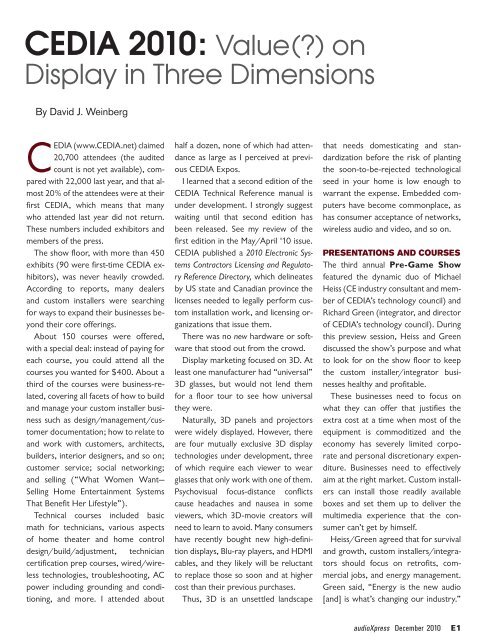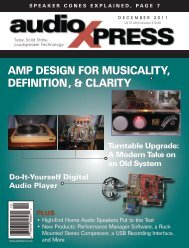A TUNE-UP FOR THE DUAL TURNTABLE - ThaiHDbox
A TUNE-UP FOR THE DUAL TURNTABLE - ThaiHDbox
A TUNE-UP FOR THE DUAL TURNTABLE - ThaiHDbox
Create successful ePaper yourself
Turn your PDF publications into a flip-book with our unique Google optimized e-Paper software.
CEDIA 2010: Value(?) on<br />
Display in Three Dimensions<br />
By David J. Weinberg<br />
CEDIA (www.CEDIA.net) claimed<br />
20,700 attendees (the audited<br />
count is not yet available), compared<br />
with 22,000 last year, and that almost<br />
20% of the attendees were at their<br />
first CEDIA, which means that many<br />
who attended last year did not return.<br />
These numbers included exhibitors and<br />
members of the press.<br />
The show floor, with more than 450<br />
exhibits (90 were first-time CEDIA exhibitors),<br />
was never heavily crowded.<br />
According to reports, many dealers<br />
and custom installers were searching<br />
for ways to expand their businesses beyond<br />
their core offerings.<br />
About 150 courses were offered,<br />
with a special deal: instead of paying for<br />
each course, you could attend all the<br />
courses you wanted for $400. About a<br />
third of the courses were business-related,<br />
covering all facets of how to build<br />
and manage your custom installer business<br />
such as design/management/customer<br />
documentation; how to relate to<br />
and work with customers, architects,<br />
builders, interior designers, and so on;<br />
customer service; social networking;<br />
and selling (“What Women Want—<br />
Selling Home Entertainment Systems<br />
That Benefit Her Lifestyle”).<br />
Technical courses included basic<br />
math for technicians, various aspects<br />
of home theater and home control<br />
design/build/adjustment, technician<br />
certification prep courses, wired/wireless<br />
technologies, troubleshooting, AC<br />
power including grounding and conditioning,<br />
and more. I attended about<br />
half a dozen, none of which had attendance<br />
as large as I perceived at previous<br />
CEDIA Expos.<br />
I learned that a second edition of the<br />
CEDIA Technical Reference manual is<br />
under development. I strongly suggest<br />
waiting until that second edition has<br />
been released. See my review of the<br />
first edition in the May/April '10 issue.<br />
CEDIA published a 2010 Electronic Systems<br />
Contractors Licensing and Regulatory<br />
Reference Directory, which delineates<br />
by US state and Canadian province the<br />
licenses needed to legally perform custom<br />
installation work, and licensing organizations<br />
that issue them.<br />
There was no new hardware or software<br />
that stood out from the crowd.<br />
Display marketing focused on 3D. At<br />
least one manufacturer had “universal”<br />
3D glasses, but would not lend them<br />
for a floor tour to see how universal<br />
they were.<br />
Naturally, 3D panels and projectors<br />
were widely displayed. However, there<br />
are four mutually exclusive 3D display<br />
technologies under development, three<br />
of which require each viewer to wear<br />
glasses that only work with one of them.<br />
Psychovisual focus-distance conflicts<br />
cause headaches and nausea in some<br />
viewers, which 3D-movie creators will<br />
need to learn to avoid. Many consumers<br />
have recently bought new high-definition<br />
displays, Blu-ray players, and HDMI<br />
cables, and they likely will be reluctant<br />
to replace those so soon and at higher<br />
cost than their previous purchases.<br />
Thus, 3D is an unsettled landscape<br />
that needs domesticating and standardization<br />
before the risk of planting<br />
the soon-to-be-rejected technological<br />
seed in your home is low enough to<br />
warrant the expense. Embedded computers<br />
have become commonplace, as<br />
has consumer acceptance of networks,<br />
wireless audio and video, and so on.<br />
PRESENTATIONS AND COURSES<br />
The third annual Pre-Game Show<br />
featured the dynamic duo of Michael<br />
Heiss (CE industry consultant and member<br />
of CEDIA’s technology council) and<br />
Richard Green (integrator, and director<br />
of CEDIA’s technology council). During<br />
this preview session, Heiss and Green<br />
discussed the show’s purpose and what<br />
to look for on the show floor to keep<br />
the custom installer/integrator businesses<br />
healthy and profitable.<br />
These businesses need to focus on<br />
what they can offer that justifies the<br />
extra cost at a time when most of the<br />
equipment is commoditized and the<br />
economy has severely limited corporate<br />
and personal discretionary expenditure.<br />
Businesses need to effectively<br />
aim at the right market. Custom installers<br />
can install those readily available<br />
boxes and set them up to deliver the<br />
multimedia experience that the consumer<br />
can’t get by himself.<br />
Heiss/Green agreed that for survival<br />
and growth, custom installers/integrators<br />
should focus on retrofits, commercial<br />
jobs, and energy management.<br />
Green said, “Energy is the new audio<br />
[and] is what’s changing our industry.”<br />
audioXpress December 2010 E1



